Bionic plants and electric algae may usher in a greener future
Some of the new tech can help clean the environment, others would just avoid dirtying it
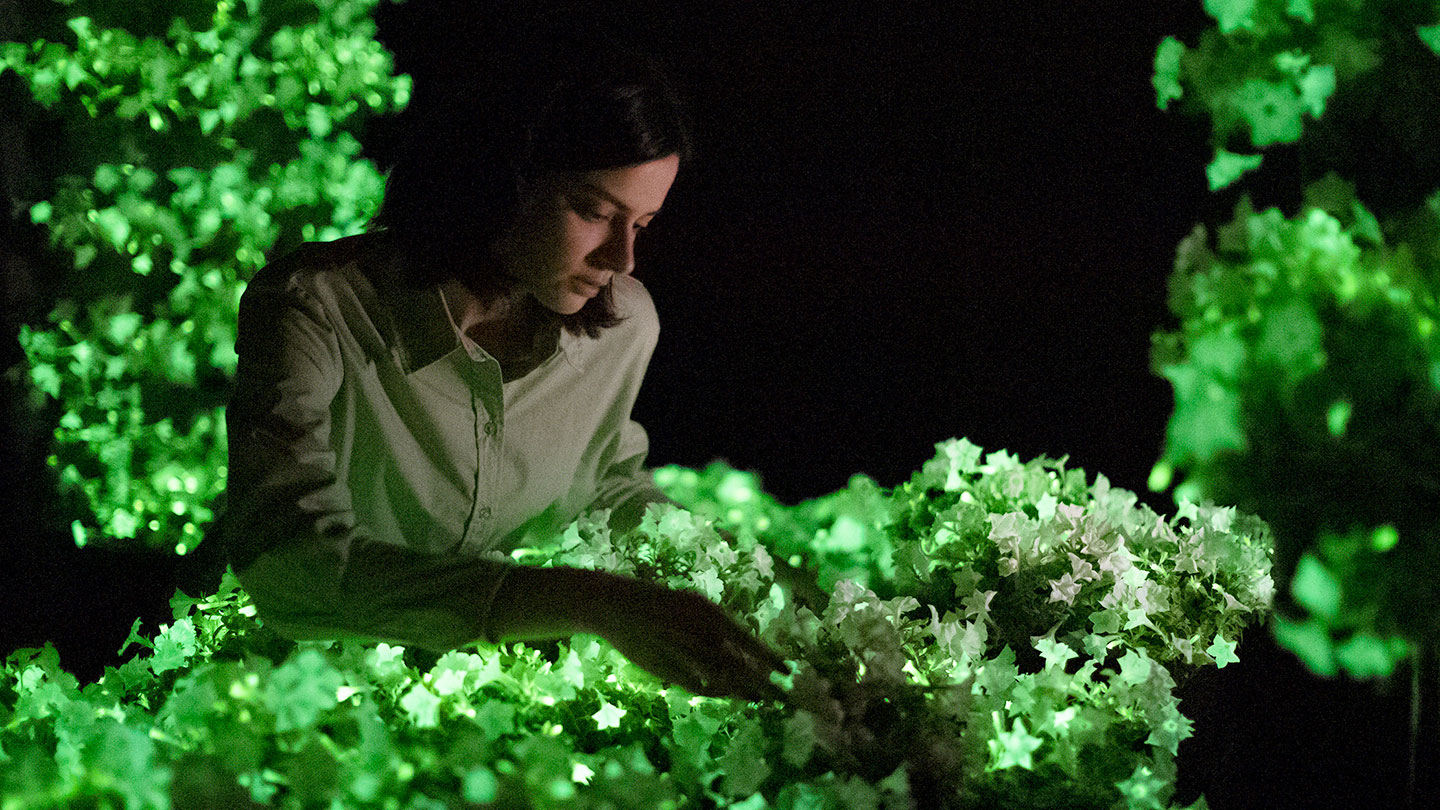
These green leaves are not illuminated by lights. Their glow comes from within. This glow-in-the-dark trait is part of their DNA, due to some fancy bioengineering. The goal: Make tomorrow’s technology more in tune with nature.
K. Wood/Light Bio
This is another in our series of stories identifying new technologies and actions that can slow climate change, reduce its impacts or help communities cope with a rapidly changing world.
The Kingdom of Bhutan snakes along the rocky spine of the Himalayas. Locals call this country “the land of the thunder dragon.” That name refers to the vivid lightning that crackles overhead from clouded mountaintops. Bhutan allows very few visitors. That’s why American Michael Strano was so honored when the nation’s Ministry of Science sent him a personal invite.
This chemical engineer works at the Massachusetts Institute of Technology (MIT) in Cambridge. Many in Bhutan’s leadership told him they’re working to bring electricity and technology to their people. “They want to develop,” says Strano. But they want to do so “in harmony with nature.”
So why did this cloudland kingdom reach out to him?
In 2017, videos from Strano’s lab showed a plant glowing with ethereal green light. It was illuminating the open pages of Milton’s 17th century epic poem, Paradise Lost. That video described a whimsical new vision for the future. Glow-in-the-dark trees might replace streetlights. People might take midnight walks through arched tree-lined corridors of glowing fairy fire.
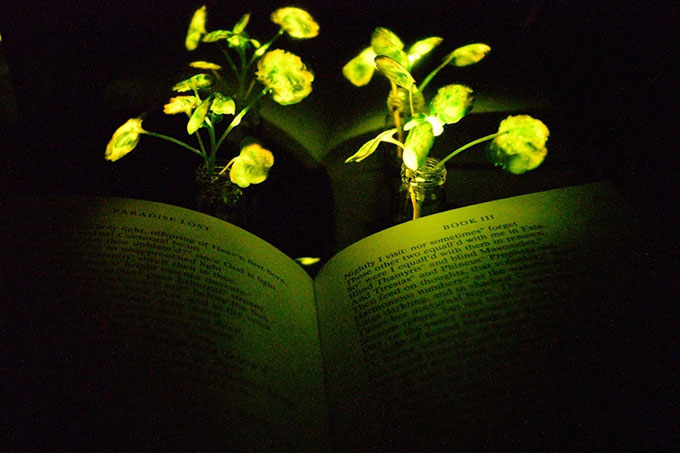
After Bhutan’s leaders “saw our light-emitting plant,” Strano says, “we had a long discussion about plant-based lighting.” He proudly adds that he now has “a standing invitation to showcase it there in Bhutan.”
But he is far from the only researcher looking to replace electronics and improve city life with plant-like hybrids.
Serbian scientists are developing “liquid trees.” These start as a city bench. Attached to the seating is a watery system that’s been engineered to suck in air pollutants. Across the globe, others are inventing glow-in-the-dark houseplants and photosynthesis-powered circuitry.
The goal of all these: to work with nature — not against it.
Using a pollutant to fuel green tech
“Plants are amazing,” says Strano. “I see good technology all the time,” he notes. But “a tree is actually enormously sophisticated technology. Just by being a tree!”
For one thing, a storm may break or rip a tree. But trees can self-repair, he says. Most of the “things that humans make do not do this.”
Plants also tap into the sun — a low-cost, renewable energy source. Its light enables plants to pull carbon dioxide (CO2) from the air and turn it into the sugars the greenery needs to grow. We call that process photosynthesis. In Latin, that means “to make with light.” Fossil records suggest photosynthesis has sustained living things reliably for the last 3 billion years.
Most of the energy we rely on for heating, cooling, transportation, business operations and running factories instead comes from either burning things (wood or fossil fuels) or nuclear power. The first of those adds CO2 — a climate-warming pollutant. And both burning and nuclear power emit heat as they release the fuel’s pent-up energy.
Plants don’t release CO2 or heat.
That’s why Strano wants to replace streetlights with plants. These tree-lamps would remove heat-trapping CO2 from the environment.
Back in 2017, Strano’s team inserted nanoparticles into living arugula — a leafy cousin of broccoli and kale. A “nanoparticle is just a very, very small particle,” Strano says. “Think of them like Legos,” he adds. They can come together to build more complex things. Strano’s team now uses them to modify the insides of plants.
They started with two types of nanoparticles. One contains luciferin — the chemical secret to a firefly’s glow. The second type contains a chemical that recycles the used luciferin so that it can be reused. This nanoparticle duo allowed green plants to do what they couldn’t before: glow in the dark. What’s more, these plants used their own stored energy to power that glow.
In 2021, the researchers added a third type of nanoparticle to transform common plants — such as basil, daisies and watercress — into even better living lights. Now they can absorb and then re-emit light. This can allow them to glow in the dark for nearly four hours. And with some tweaks to the nanoparticle size, these plants glow 10 times brighter than before.
The team published its findings in Science Advances.

Educators and Parents, Sign Up for The Cheat Sheet
Weekly updates to help you use Science News Explores in the learning environment
Thank you for signing up!
There was a problem signing you up.
The human happiness component
In 2016, Bhutan’s Prime Minister — Tshering Tobgay — gave a TED Talk about the country’s environmental priorities. “Of the 200-odd countries in the world today,” he said, “it looks like we are the only one that’s carbon neutral.” Then he added, “But actually … Bhutan is not carbon neutral. Bhutan is carbon negative.” That means the Land of the Thunder Dragon takes more CO2 out of the air than it puts in.
Bhutan’s forests deserve much of the credit for this. Trees cover more than 70 percent of the country. A commitment to preserving these forests is part of the country’s constitution. The nation has pledged to preserve 60 percent of its forests “for all time.” That’s one measure of how Bhutan values harmony between plants and people.

But technology built around greenery may do more than provide clean energy and city lights. It may also make us happier. Bhutan certainly thinks so. The country uses a unique philosophy for balancing its national budget and spending with environmental and cultural conservation. They call it their Gross National Happiness.
Studies suggest that being around plants makes us happier. That’s one reason cities have parks and other green spaces, Strano notes. “We’ve learned that we can’t just smear everything with concrete” and expect people to feel content.
Strano believes that our connection to nature is ingrained. As humans, “we’ve spent a hundred thousand years in [a plant-rich] environment,” he says. That’s what we evolved to appreciate, he adds, not the big cities that society has created only relatively recently.
And Strano’s not alone in this thinking.
Glow-in-the-dark houseplants
Back in 2019, Keith Wood helped start a glow-in-the-dark plant company in Ketchum, Idaho. It’s called Light Bio. “Our mission,” Wood says, “is to build [deeper] connections between people and plants through this living energy.”
Wood’s approach is very different from what the MIT group is doing. In Strano’s plants, the light comes from glowing particles inserted into the plant. Wood’s team instead has altered the DNA of the plants, allowing them to produce their own glow. That also means their seeds can grow into luminous plants.
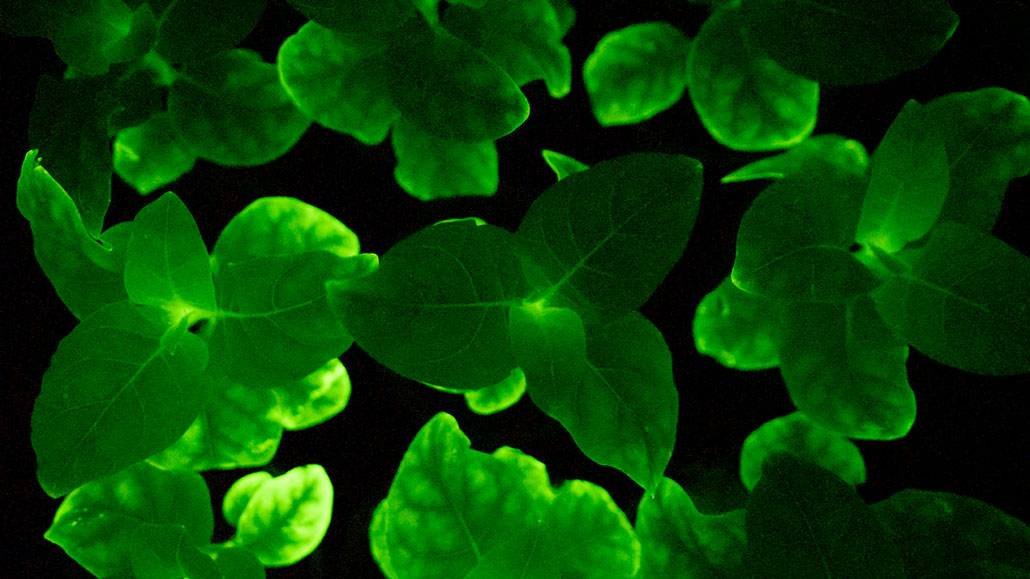
“It’s living light,” Wood says. The glow you see is produced “from the living energy of the plant.”
In September, the U.S. Department of Agriculture gave Light Bio the green light to sell its glow-in-the-dark petunia. The company says its “Firefly Petunia” will be available for purchase in early 2024.
Wood helped create the first glow-in-the-dark plants while a graduate student in 1986. Those plants used firefly luciferin and emitted only a faint glow. His plants have undergone major upgrades since then. Now they use genes from bioluminescent mushrooms. Those mushroom genes really brighten the glow, Wood says.
Wood’s group is now working on giving plants “a whole range of colors.” He also envisions someday having plants whose glow is touch-activated. He says they should offer “a true, personal interaction between yourself and this plant — in a way that just never was possible.”
So, does Wood have glowing plants in his home?
“I do,” he says. “And it’s just completely magical!”
Beyond lighting
Scientists in Serbia have been exploring a different way to green their cities. Here, though, the main goal is to remove air pollution. Called LIQUID3, the tech is a vibrant tank of microalgae installed as part of a city bench.
The entire setup is about the size of a small bus stop. Vivid green microalgae (Chlorella sorokiniana) drift in a lighted aquarium-like tank. These one-celled organisms “perform photosynthesis, like plants,” explains Ivan Spasojević. He’s a biophysicist at the University of Belgrade in Serbia.
LIQUID3 was not designed to replace trees, he says. Instead, it adds some of the benefits of greenery — such as cleaning polluted air — at sites where trees might not grow well. That can include narrow areas along crowded city streets.
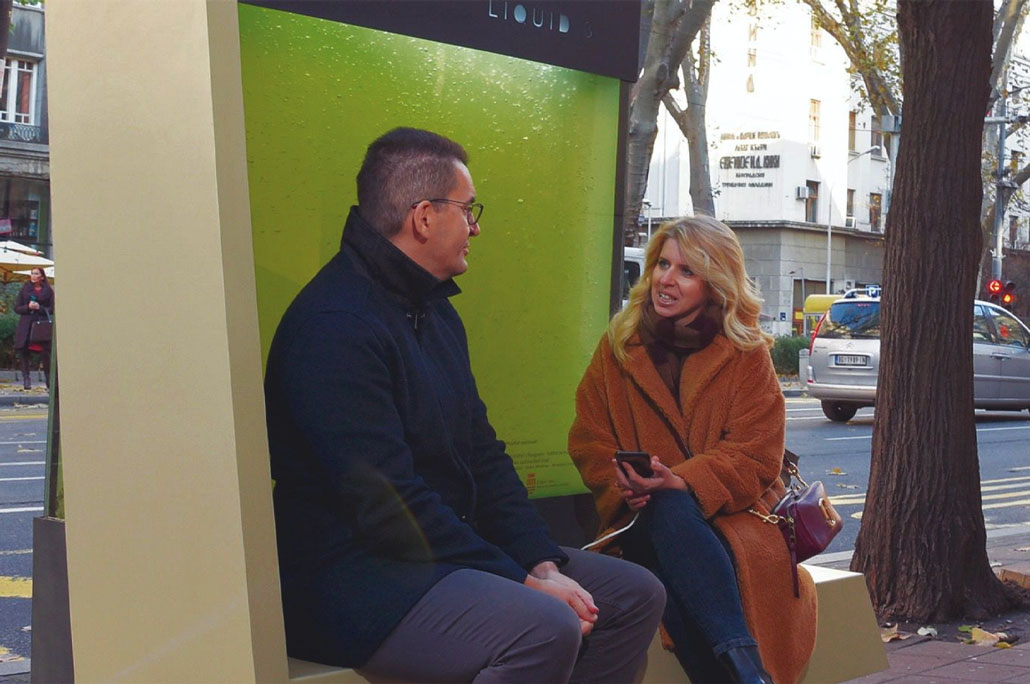
The algae survive in polluted areas better than trees. And they excel at cleaning heavy metals from the air. The Belgrade team described its system’s success two years ago in Free Radical Biology and Medicine.
The system also sucks up CO2, which could be good for the climate. But that benefit only lasts if the dead algae or any overgrowth — which is removed monthly — is not then allowed to rot. Rotting would risk releasing that CO2 back into the air.
At the same time, Spasojević notes, people must find this system useful for it to catch on. That’s why it’s being integrated into benches that offer people a phone-charging station and soothing nightlights. (Solar panels provide energy for those tasks.)
In September 2021, the team installed its first LIQUID3 in Belgrade. Since then, it’s been “working well,” Spasojević says. “We are building two more units,” he adds, and more orders are underway.
Working with plants for a sustainable future
Other electronics developers also have an interest in photosynthetic microbes. Instead of plugging in computers to recharge their batteries, one day we might water them — to support their photosynthetic power source. We’re not there yet, but it may not be that far-fetched.
Last year, researchers from the University of Cambridge in England hacked into blue-green algae’s energy source. Then they captured some of its photosynthetic energy to power a small computer chip. So far, it’s been running for more than a year. The team shared its design in Energy & Environmental Science.
Jenny Zhang, who studies photosynthesis at Cambridge, worked on a related project. When plants tap into the sun’s light, they generate a bit of electricity. This helps power other steps in the process. Zhang works with blue-green algae, which carry out photosynthesis similar to plants. Zhang and her team used the blue-green algae’s transformation of light into electricity — in this case to power electronics. In the future, she hopes it might help synthesize fuels.
You might think stealing energy would hurt the algae. In fact, it did the opposite.
When sunlight strikes blue-green algae — or plants — the light wakes sleepy electrons inside of them. Sunbeams super-energize those electrons, which then zip away. It’s like electricity zipping down a power cord.
Plants and blue-green algae put most of that electricity to work. But if it gets too sunny, the light can overwhelm them. In fact, sunlight overload “is one of the biggest problems in agriculture,” says Zhang. If unchecked, supercharged electrons can cause havoc and hurt the plants.
Fortunately, to cope, plants have a trick up their stems. To avoid being damaged, plants and blue-green algae basically throw away excess energized electrons. Think of this as a safety valve popping open and relieving pressure.
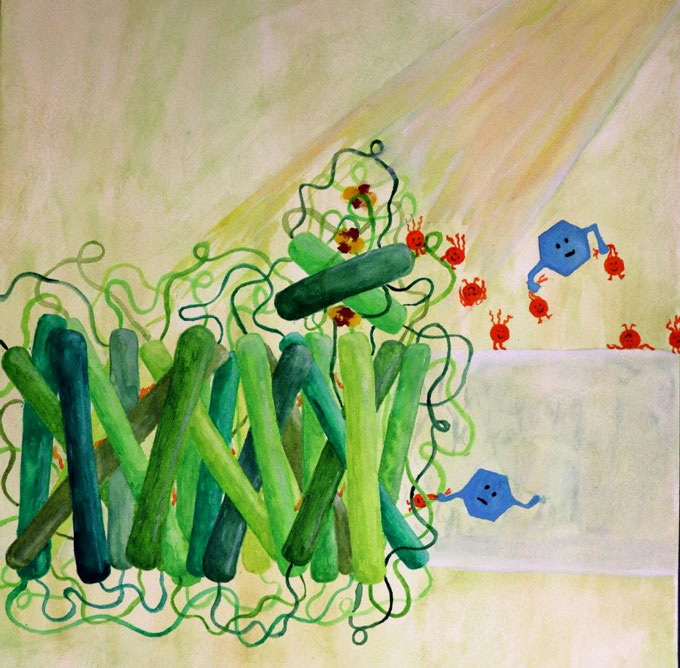
It’s these wasted electrons that Zhang’s group now steals. It’s a bit like upcycling someone’s trash. In Nature Materials last year, the researchers described how they put these upcycled electrons to work.
Imagine where this technology could take us, Zhang says. We could generate electricity from these “stolen” electrons. Zhang hopes photosynthetic electricity might one day run our cars and electrical devices. We might even use them to make fuels, she says, such as hydrogen fuel. What’s so exciting, Zhang says, is that “it’s sort of like a win-win situation for the plant and for us.” The plant benefits from the clean-up of those excess electrons. People benefit by having access to a sunny, renewable energy source.
A plant-like approach to energy
Such projects suggest living green things could change how people manage energy.
Ozgur Sahin studies nature-inspired energy at Columbia University in New York City. Consider how humans generate electricity at electric-power plants, he says. They’re a concentrated source of electricity. But much of that electricity gets lost as it moves down power lines from the generating station to our homes.
Plants take a different approach. Trees in a forest don’t need to connect to a power grid. Each individual tree in a forest manages its own energy. And perhaps cities could take a leaf out of their playbook.
Strano hopes his glowing plants could help us move away from the centralized power approach we use today. “Instead of streetlights hooked up to an electrical grid,” he says, imagine trees replacing streetlights. The sun will power each tree to help clean the air of CO2. And later they can light the night.
Such a partnership could usher in an enlightened — and greener — future.







